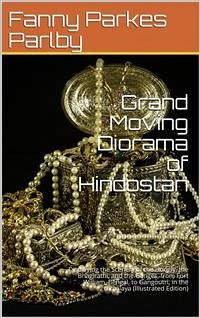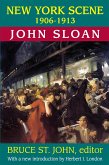In 1851, the year of The Great Exhibition of the Works of Industry of all Nations, Fanny instigated and funded the construction of a ‘Grand Moving Diorama of Hindostan’ which was staged at the Asiatic Gallery in the Baker Street Bazaar. India, Britain’s ‘jewel in the crown’, featured centre-stage at the Great Exhibition, the East India Company itself having been one of the most enthusiastic supporters of the enterprise from its inception. They saw the exhibition as an opportunity to astonish visitors with the exquisitely crafted riches from Britain’s Eastern Empire. They also saw it as a way of promoting a new self-image through the collecting and display of objects from the sub-continent.
The Grand Moving Diorama of Hindostan offered not objects but vistas, visual evocations of the landscapes of India, specifically those seen from India’s most sacred river, the Ganges. As such, it gave a context to the Great Exhibition’s display of astonishing objects made in India. The description that survives makes it clear that Fanny’s diorama was no run-of-the-mill affair and was modelled on the moving dioramas invented by Daguerre, the first of which was brought to England in 1823. Panoramas and dioramas were a popular attraction in the first half of the nineteenth century. While panoramas were essentially very large, realistic, paintings of a scene, dioramas, which also used painted backdrops, introduced a three-dimensional element to the viewing experience. Daguerre’s diorama, first shown in Paris in 1822, was brought to London in 1823 and erected in a special building constructed in Regent’s Park at a cost of £10,000.
The ‘Grand Moving Diorama of Hindostan’ was sufficiently popular for it to be exhibited in Hull in 1853, although the transport of the equipment from London to Hull would have been a challenging exercise. An additional attraction to London visitors to the diorama was the promise that they would be ‘allowed to inspect THE MUSEUM ’– in other words, Fanny’s Cabinet of Curiosities.
The Grand Moving Diorama of Hindostan offered not objects but vistas, visual evocations of the landscapes of India, specifically those seen from India’s most sacred river, the Ganges. As such, it gave a context to the Great Exhibition’s display of astonishing objects made in India. The description that survives makes it clear that Fanny’s diorama was no run-of-the-mill affair and was modelled on the moving dioramas invented by Daguerre, the first of which was brought to England in 1823. Panoramas and dioramas were a popular attraction in the first half of the nineteenth century. While panoramas were essentially very large, realistic, paintings of a scene, dioramas, which also used painted backdrops, introduced a three-dimensional element to the viewing experience. Daguerre’s diorama, first shown in Paris in 1822, was brought to London in 1823 and erected in a special building constructed in Regent’s Park at a cost of £10,000.
The ‘Grand Moving Diorama of Hindostan’ was sufficiently popular for it to be exhibited in Hull in 1853, although the transport of the equipment from London to Hull would have been a challenging exercise. An additional attraction to London visitors to the diorama was the promise that they would be ‘allowed to inspect THE MUSEUM ’– in other words, Fanny’s Cabinet of Curiosities.









